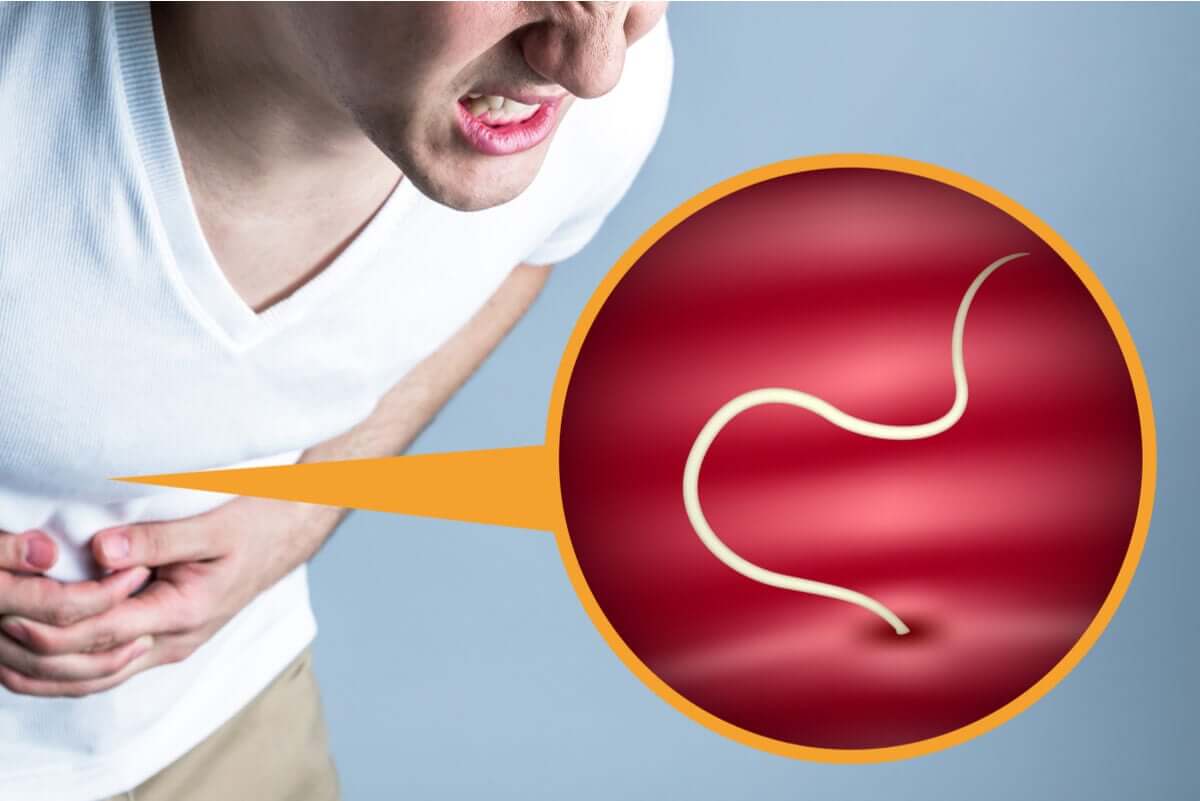Discover the Most Common Food Parasites


Written and verified by the nutritionist Saúl Sánchez Arias
Food parasites are several microorganisms that can pose a risk to human health.
They’re ingested through the diet and have the ability to colonize some sections of the intestinal tract or generate harmful toxins. It’s important to know which are the most common and be aware of necessary measures to avoid their consumption.
It’s worth noting that one of the most frequent causes of visiting the emergency room is food poisoning. This situation is usually the result of bad hygiene practices, which ends with the ingestion of pathogens that cause digestive problems.
However, some of them can develop allergic processes and affect other vital organs, such as the liver. What other dangers do they cause?
In the following article, we’ll tell you more about them.
Dangers of food parasites
On many occasions, people consume food parasites without being aware of their presence in the food due to their small size. It’s also possible that the product contains only the eggs of the pathogen, which will hatch in the intestinal tract to cause short-term damage.
This is perhaps one of the most complicated cases to treat since the parasite settles inside the subject and causes a constant health problem. It’s important to note that this series of organisms can develop in very diverse foods. They can appear in fresh products, but also canned foods.
It’s relatively common to find them in meat that hasn’t undergone proper treatment, even in some fish. Once they develop inside the body, they can spread through contact, especially if there’s poor hand hygiene.

The main food parasites
An article published in Advances in Food and Nutrition Research states that foodborne parasites are one of the most neglected groups of pathogens. This is because of their complexity and high prevalence in marginalized populations. However, in recent years they’ve spread to other populations and have produced unexpected symptoms.
Which are the most common food parasites? And how can you reduce the risk of contamination? Answering these questions is very important, so we’ll provide more details below.
Taenia solium
Taenia’s also known as “pork tapeworm“. It’s a microorganism that we find mainly in pork that hasn’t undergone proper treatment or sanitization during the process that occurs in the slaughterhouse.
As a result of the consumption of contaminated food, tapeworms can develop inside the intestine. They have a worm-like appearance and have the ability to ingest the nutrients that we consume through our diet.
According to a study that appeared in the journal Parasite Immunology, this can cause progressive weight loss in humans. This, of course, leads to a consequent state of malnutrition.
Echinococcus granulosus
This is usually a parasite that lives in the intestines of dogs. However, research has shown that it can also spread to humans from the consumption of contaminated meat from other animals, such as pork.
It’s a tapeworm-shaped organism, although small in size. It causes protein consumption that reduces the bioavailability of amino acids for human use. Consequently, it damages health in a significant way.
To know more: Can You Eat Food that Has Fallen on the Ground?
Toxoplasma gondii
This protozoon can cause toxoplasmosis in humans. It’s a microorganism that lives primarily in cats, although its passage to pregnant women generates negative consequences for the fetus.
The treatment of toxoplasmosis requires a series of drugs that manage to act on the synthesis of folic acid. Treatment thereby produces a negative impact on the life and reproductive cycle of the parasite.
In the clinical picture of toxoplasmosis, flu-like symptoms such as fever stand out. This disease can even be fatal in the case of immunosuppressed individuals.
Also, some research suggests that infection with this pathogen may increase the risk of developing schizophrenia in the medium term.
Strategies to reduce risks
One of the most effective mechanisms to reduce the risk of developing a foodborne parasite infection is to take extreme food hygiene measures. In this sense, it’s crucial to carry out the correct washing of fresh consumption products, except in the case of meat products.
Also, it’s important to ensure that you reach a high internal temperature inside the food during cooking. That’s because this is an effective mechanism for exterminating pathogens that may be inside the food.
At the same time, you should never use the same utensils for handling raw and cooked food. It’s also important to sanitize cutlery optimally, as well as to wash your hands before handling food.
In the case of subjecting any food to a freezing process, you should always defrost it in the refrigerator afterward and avoid leaving the product at room temperature. This could promote the hatching of any eggs that are inside it or on the surface.

You may also be interested in: 5 Fake News Stories about Food
Beware of food parasites
Contracting an infection caused by food parasites is relatively frequent, and it’s a problem that can seriously compromise human health. Not only does it affect the metabolism of nutrients or the availability of nutrients, but it can also lead to liver damage and even a life-threatening hypersensitivity reaction.
Moreover, in the case of pregnant women, certain poisonings are very dangerous, since they manage to endanger the life of the fetus. In this sense, we advise you to always acquire food of the highest quality, which has passed the sanitary controls and which has proper certification.
At the same time, you must cook food completely to ensure that any pathogens living inside it are destroyed. In the case of preserving products, use methods that are safe and that manage to keep the food in good condition to prevent the reproduction of parasites.
All cited sources were thoroughly reviewed by our team to ensure their quality, reliability, currency, and validity. The bibliography of this article was considered reliable and of academic or scientific accuracy.
- Gonzales I., Rivera JT., Garcia HH., et al., Pathogenesis of taenia solium taeniasis and cysticercosis. Parasite immunol, 2016. 38 (3): 136-46.
-
Robertson, L. J. (2018). Parasites in Food: From a Neglected Position to an Emerging Issue. In Biological Emerging Risks in Foods (pp. 71–113). Elsevier. https://doi.org/10.1016/bs.afnr.2018.04.003
- Almulhim AM., John S., Echinococcus granulosus. StatPerals, 2020.
- Xiao J., Prandovszky E., Kannan G., Pletnikov MV., et al., Toxoplasma gondii: biological parameters of the connection to schizophrenia. Schizophr Bull, 2018. 44 (5): 983-992.
This text is provided for informational purposes only and does not replace consultation with a professional. If in doubt, consult your specialist.








